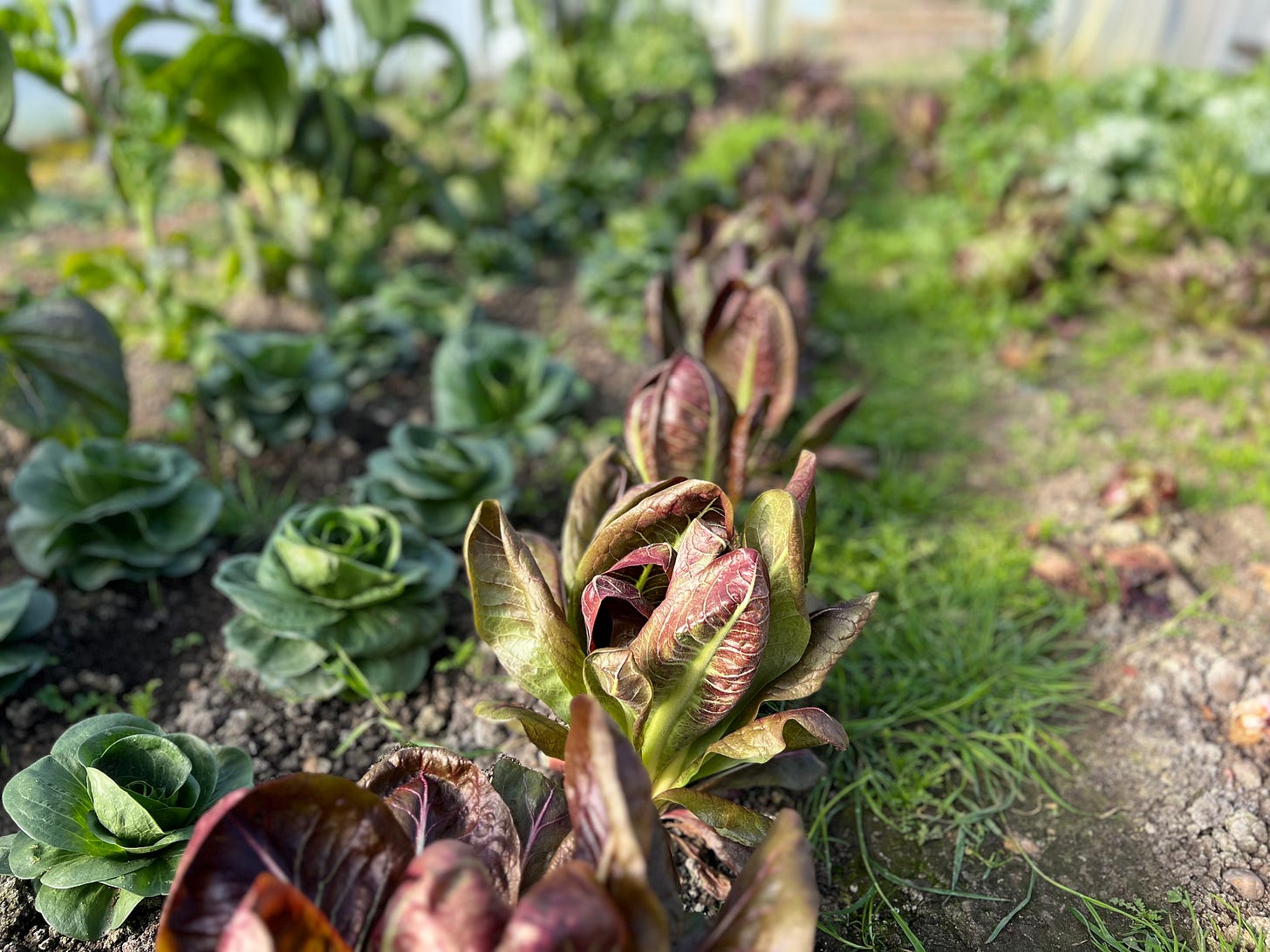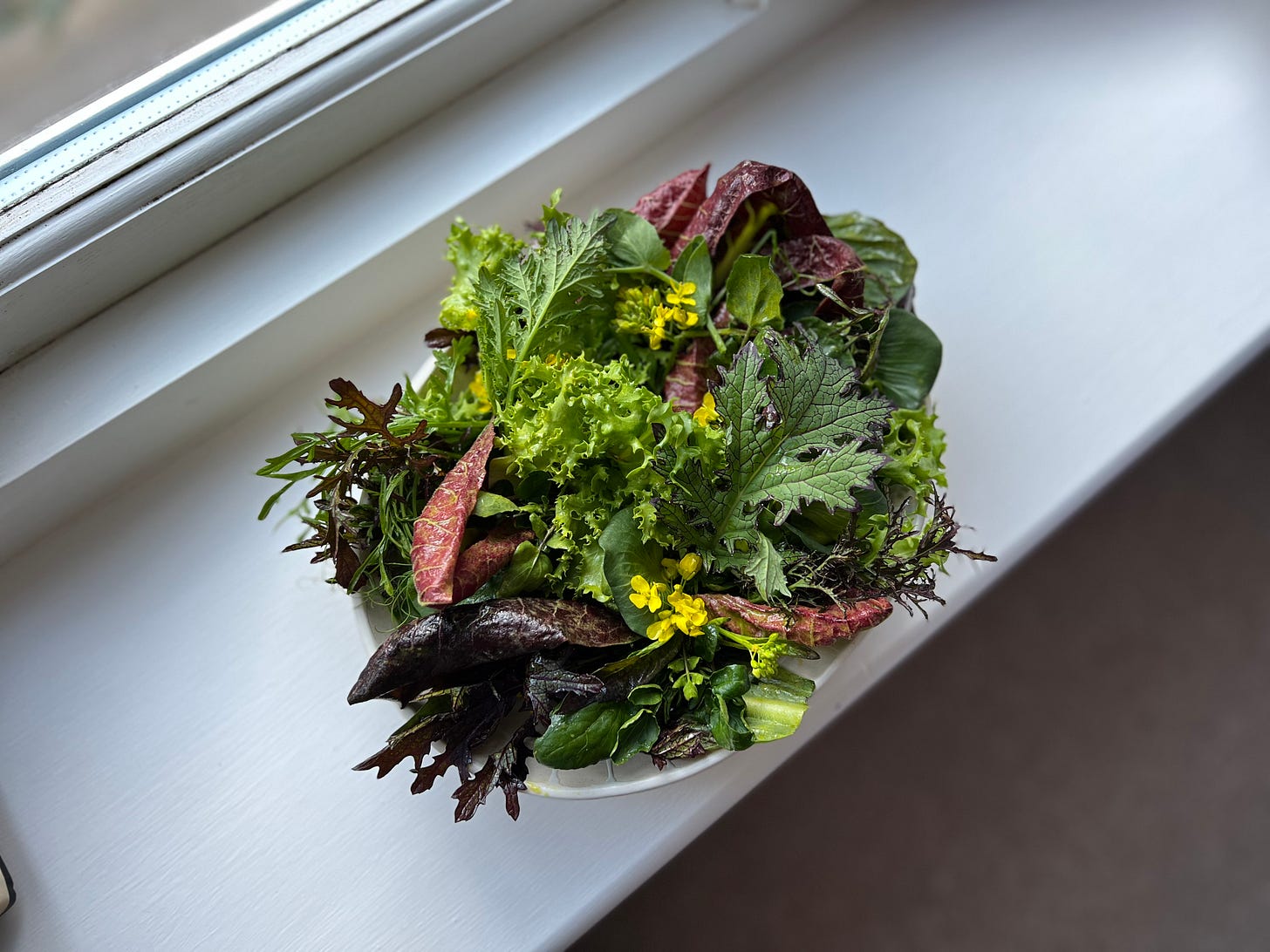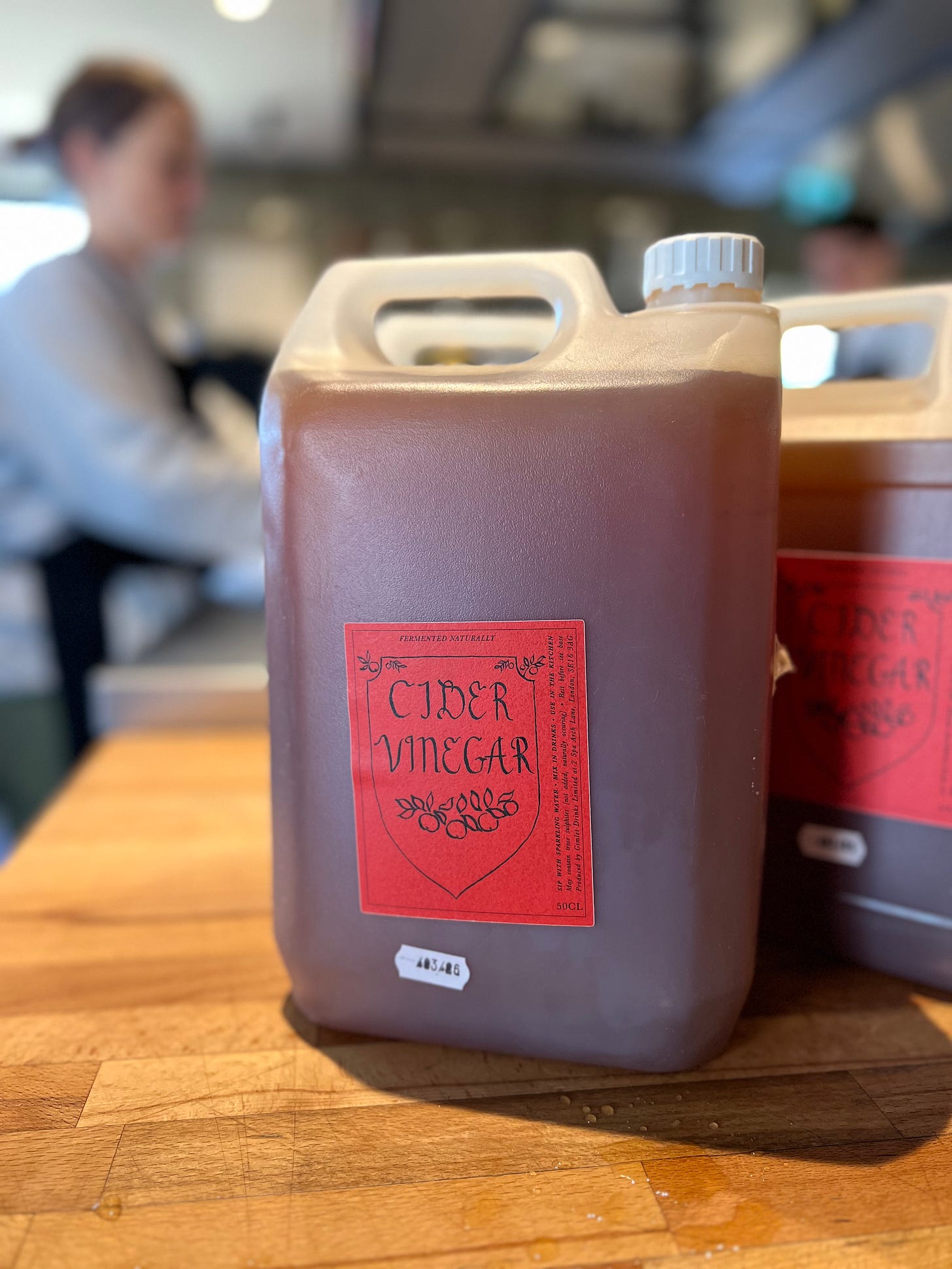Why salad is always best in spring
A recipe for my favourite green salad, and two ways you can make any coming-together of leaves taste wonderful.
I’ve always maintained that when staring down by your feet at the earthly canvas of any farm or garden, there is no greater reflection of time, place and persons than a bed of salad leaves. Whether it be the deep-coloured bitter heads of autumn or the red-flecked lettuces of summer. I daresay many green-thumbed cooks or growers can detail the very month of the year by studying the palettes, shades and vigour of a lettuce, mustard or cress. They’re a time stamp of the growing season.
Spring is undoubtedly the best time of year to enjoy a bowl of leaves. Often sown in autumn or late winter, by springtime plants have grown slowly and usually under cover, building a deep character and flavour as they do so. Unlike the hurried growth of summer’s salad - thrown into a lazy but rampant surge thanks to an abundance in warmth and water - winter salads have experienced the stresses of biting temperatures and low-light. They’ve lived a longer and more arduous life than their midsummer siblings, and have much more to say for themselves in the salad bowl because of it.
Mustards are more fiery and lettuces are infinitely more interesting. Bitter radicchios and peppery cress command your attention and that of the table. Spring’s new growth of pea shoots, lamb’s lettuce and broad bean tips soften the hardier edges of winter’s bolder leaves and makes a mesclun that April alone can bring.
The line-up of leaves
My allotment (newly acquired) is presently barren but for a few leeks and a growing collection of muddy bale twine from the previous tenants, so my search for spring salad took me to friends Bess, Helena and Ada at Maple Farm in Kelsale. Their certified organic polytunnels house a great many leaves. I filled my colander with;
Mustard flowers, from bolting plants
When deciding the varieties you’d like for your salad the best starting point is, as is often the case in the kitchen, the end. Imagine the first mouthful and the coming-together of leaves - would you like the character of the bowl to be aromatic, fiery, peppery, herbaceous or a clean and crunchy mixture that compliments, rather than commands? What follows is my favourite way to bring the leaves of spring together. As I’m sure you’ll learn with each entry I add to this newsletter, the recipes you’ll find here are thoughtfully prepared but simply presented. I like whatever my hands place on the plate to be a true reflection of that time and place. I hope the tips that follow will help you do just that in your own kitchen at home.
Leaves acquired, our attention must now turn to adornments.
Cooks much wiser and more confident than me (namely Tom Adams and Rose Maxwell at Coombeshead Farm) might reach for the vinegar bottle and little else. If you have access to fine salad leaves, and can harvest them a moment or two before serving, then you’ll likely agree this to be the best course of action. Construct your salad in a handsome bowl, allowing each leaf to play its part and flaunt its natural shape. Just before serving, administer a spritz or two of vinegar that’s had a pinch of fine salt added to it, to help season the leaves. In my mind, this is the ultimate flex; “Look here at what I have to hand (or have grown!), and how little it needs to shine so brightly!”.
I always enjoy a drop or two of vinaigrette, and in an attempt to dial-up the very essence of spring, I assemble it with a macerated vinegar (vinegar infused with leaves, fruit, herbs or flowers) and a herb oil.
For the woodland vinegar
In April the hedgerows and woodlands are bursting with the vibrant green new growth of nettles, cleavers and - if you’re near the coast - alexanders. Scrunch any of these in your hands and you’ll smell the fluorescence of that earthy green itself. This can be captured in a vinegar over as little as a week of maceration, and will only improve over time. A little of this in a salad’s dressing not only amplifies the leaves themselves, but brings a dose of that woodland aroma to the bowl.
Makes 1 x 500ml jar
A handful of nettles
A handful of cleavers
A handful of alexanders
Apple cider or white wine vinegar, about 400ml
1. To a clean jar, add the nettles, cleavers and alexanders, pushing them down and filling the jar as much as possible. Cover with vinegar, seal the jar and leave somewhere cool and dark to macerate for at least a week.
For the lovage oil
I adore herbs in a salad but find their sudden arrival in a mouthful (tarragon! Chervil!) can negate the hard work you’ve already done in composing the balance of your leaves. The flavour of a herb oil, however, brings a gentle and even flavour and a vivid green that only amplifies all of the salad’s existing qualities. My favourite herb for the task is lovage, especially vivid and delicious during its first spring growth. You can use any soft herb you have to hand with equally delicious results. The yield is admittedly poor, but what it lacks in volume it makes up for in colour and flavour - a little goes a long way. I use rapeseed oil here as I can get a very good one that’s grown and processed locally to me, but sunflower oil would work well, too. I generally avoid vegetable oil as, for the most part, it’s produced from soy beans.
Makes 200-300ml
300g rapeseed or sunflower oil
300g lovage, or any fresh soft herb
1. Warm the oil slightly in a small saucepan, to around 50c or thereabouts (this helps extract the flavour and colour from the herb), then add to a high-powered blender with the lovage. Blend, slowly at first, until the lovage and oil are largely combined and minced together. Blitz for 7 minutes, gradually increasing the speed as time goes on. It may have moments of stillness (and will be loud!) as air pockets form, but adjust the speed a level or two lower and it should remedy itself.
2. Strain through a sieve lined with muslin or kitchen towel for an hour or so, being careful not to squeeze it at any point, as this forces through water from the herbs, rather than the newly infused oil. Store in a container in the fridge where it will keep happily for a couple of weeks.
For the vinaigrette
I find this method for making a small batch of vinaigrette not only incredibly quick, but most satisfying in the way it leaves whisk, bowl and food processor free and clean for another purpose.
Makes 1 x 400ml jar, enough for many salads
50g Dijon mustard
100ml lovage oil, or olive oil
100ml woodland vinegar, or apple cider vinegar
Flaky salt (I love Halen Mon)
1. In a clean jar, add all of the ingredients. Secure the lid and shake vigorously for a moment or two, until all is emulsified and the mixture has thickened slightly. Open the jar and check the seasoning, remembering you want a good vinaigrette to be slightly too salty and too acidic at this time, while in the absence of the leaves it’ll meet later.
To assemble the salad
Into a large bowl, add the washed leaves - allowing 30-40g per person. Add vinaigrette to taste, mixing lightly with your hands, feeling to ensure each leaf is lightly coated in its vibrant dressing. Taste and adjust the vinaigrette quantity to your liking. Serve immediately.
Notes
- The possibilities of a macerated vinegar are endless. Be guided by what you have to hand, or the purpose you’d like to use it for in the kitchen. Bay or myrtle vinegar is wonderful for deglazing roasting pans of poultry. Blossom vinegar adds a beautiful fragrance to meringues. Fruit and herb vinegar can provide a welcome home for any less-than-perfect leaves, herb stalks or berries and captures their flavour so well. Try adding a dash to a compote or jam to bring a little balance and an additional I-can’t-quite-place-it level of flavour.
- The best, simplest and most well-remembered method for herb oil is in a Thermomix, blitzed on speed 7 for 7 minutes and at 70c. I sadly don’t own one at home, and know few cooks who do, so the recipe provided in this entry is intended to be more sympathetic to the home cook’s artillery of equipment.






A lovely post Hugh, the layers of botanical flavours must be wonderful in your dressing. Have you ever tried blanching the herb and drying before adding to the oil. It retains the colour and vibrancy more.